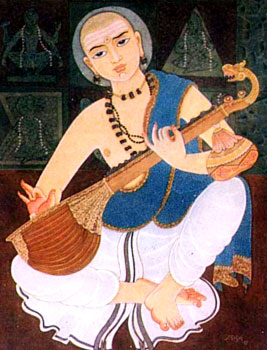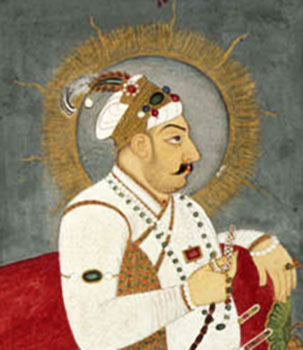 Development of Indian Music has been a slow and steady process down the ages. There can be discerned an element of continuity between the ancient and modern periods. In fact it has been seen that even now, there is hardly a book written on India music which does not reiterate the divine origins of music and the details of melodic theory given in Bharata`s Natyasastra, written sometime between the second century B.C. and the sixth century A.D.13.
Development of Indian Music has been a slow and steady process down the ages. There can be discerned an element of continuity between the ancient and modern periods. In fact it has been seen that even now, there is hardly a book written on India music which does not reiterate the divine origins of music and the details of melodic theory given in Bharata`s Natyasastra, written sometime between the second century B.C. and the sixth century A.D.13.
Since the second millennium B.C., when a group of related tribes known as the Aryans began to settle among the original Dravidian peoples and other indigenous tribes on the then sparsely settled land, the subcontinent has been populated by Aryan and Dravidian ethnic offshoots. These agricultural and pastoral groups moved constantly, searching for land, security, and riches. As the various groups settled down, India began to resemble a giant ethnic patchwork quilt, for it housed an incredible variety of local and regional cultures. The Aryan influence gradually became the dominant one; even the Dravidian peoples, who were pushed south by the more aggressive Aryans, adopted elements of the Indo-European culture and language. Sanskritisation was seen in almost the entire sub-continent, and this provided a kind of homogenous environment for the spread of philosophy and culture. In Aryan India (1500-500 B.C.), music played a rather important role. It was employed during sacrificial rites and rituals when recitations and songs were sung. In the earliest times, it seems that the main singers were women, and they were usually the wives of the Sama Vedic priests. Later, this task came to be performed by the Udgatrs or the male priests. The women in the religious sphere now functioned as singers and dancers, especially in the 9th century when temples became cultural centres. Even in the royal courts and homes the performing arts were encouraged and fostered. In the plays of Kalidasa, one of the greatest writers of ancient India there is found mention of a music school in which the most erudite teachers imparted education in the arts, music, dancing, acting and painting to the pupils from the royal household.
Music continued to grow and flourish with the encouragement being given to the performing arts. Three hundred years later, sometime in the 8th century AD, Dandin, another one of India`s great literary figures, wrote about urban and elite life in Ujjain. Utmost patronage was extended to the arts and the lifestyle was one of luxury and splendour. One of the most popular forms of entertainment among the people was the goshtis or clubs which were concerned with artistic and academic accomplishments. These were convened in public halls or the residences of artists or even in the residence of a courtesan and attended by members of the same age, wealth, learning and temperament. The two arts of music and dance were so closely inter-twined that both these terms were included in the Sanskrit word sangita- the arts of singing, playing musical instruments, and dancing. This conception of the performing arts continued through the centuries and is maintained even today. For instance, the National Academy of the Performing arts is referred to by two descriptive words only- Sangit Natak Akademi.
The twelfth and thirteenth centuries witnessed a mighty change in the life of the sub continent due to the Muslim invasion. In all, there were three Islamic invasions in the subcontinent. With the establishment of the Delhi Sultanate in AD 1206, the presence of Islam in the sub-continent became a permanent feature. They established a stronghold in the Northern parts of the country, till with coming in of Babur, the whole of North India and a considerable portion of the Deccan was affected and unified. South of the Deccan the Hindu Kingdoms continued to flourish whereas in the north Muslim power dominated.
Accounts of life in the Deccan regions had been provided by many foreign travellers who visited India. One of the earliest accounts is that of Niccolo di Conti. He visited the Southern Empire in the 15th century and spoke of the splendour and grandeur of the court which was reiterated by Paes and Muniz a century later. They spoke of how music constituted a vital element of court life. They reported women playing trumpets, drums, pipes and viols and there were a number of dancing girls and singers living in the palace. Even the wives of the King were well-versed in music. The reigning monarchs themselves were proficient musicians. The temples remained a centre for the arts in the Hindu Kingdom. It has been confirmed by Paes that during festival time the dancing girls remained dancing in front of the temple for a long time. The women were held in high regard rewarded for their talents. The Vijayanagara kings also continued the tradition of providing for vocal and instrumental music in the temples by giving grants or providing players. Thus, Hindu ideas and customs regarding music were maintained in the great kingdom until 1565, when its ruler was defeated by a coalition of Muslim sultans from the northern Deccan and the empire came to an end.
 Music in Islamic thought is not believed to have a divine origin, nor is it supposed to be performed in mosques. Even chanting in the services is not considered music. However, all this notwithstanding, the Muslim rulers in India were lavish patrons of the arts in their courts. The difference now, as compared with the earlier Hindu kings is that music was not seen as a means of self-realisation but as a means of entertainment. In the darbars (court sessions) as well as in the private living quarters, troupes of dancers and musicians were retained for the enjoyment of the royal households. It seems that the sovereigns and their families were not too inclined towards learning any music themselves.
Music in Islamic thought is not believed to have a divine origin, nor is it supposed to be performed in mosques. Even chanting in the services is not considered music. However, all this notwithstanding, the Muslim rulers in India were lavish patrons of the arts in their courts. The difference now, as compared with the earlier Hindu kings is that music was not seen as a means of self-realisation but as a means of entertainment. In the darbars (court sessions) as well as in the private living quarters, troupes of dancers and musicians were retained for the enjoyment of the royal households. It seems that the sovereigns and their families were not too inclined towards learning any music themselves.
When the British presence started being felt in India, the Mughal Empire was fast disintegrating. Consequently, the patronage that was being extended to music gradually waned. The musicians started gathering in the few courts that could afford to support them, and this included the courts of the Hindu Rajas in Gwalior, Baroda, Rampur, Indore, Udaipur and Jaipur. The last of the Delhi sultans to make lavish outlays of funds for the arts was Muhammad Shah, who ascended the Delhi throne in 1719. The other smaller local rulers now started adopting British customs and spent their wealth in pursuing the leisurely activities of the British.
However, even when musical arts were on the decline in the rest of the country, music continued to flourish in the 18th and 19th centuries in the South. This was particularly seen in the courts at Tanjore and Travancore. The nineteenth century was vibrant with the music of many composers, among them three masters: Muttuswami Dikshitar (1775-1835), Syama Sastri (1763-1827), and Tyagaraja (1767-1817), the last of whom is revered as a saint
By the twentieth century, the concept of extending patronage in the North as well as the South was on the decline. Musicians now started living and independent lifestyle where they were forced to turn to urban centres and a wider audience in order to sustain themselves. However, this system too underwent a change when the wave of nationalism took over, Music and the performing arts got a new boost due to the flowering of a spirit of Renaissance where the national arts and music were being revived.
It may be said that since the time of Indian Independence, there has been a revival of interest in the traditional arts, especially music. Today, more people are seen learning music and more concerts are being held throughout the country. Naturally, there are bound to be some differences in the musical milieus of today and those in the past. Contemporary audiences are not always well tutored in the music they are hearing. Consequently, the performer-audience give-and-take falls short of the ideal and is often different from the practice of the past. All this withstanding, there continues to be a sustained and increasing interest in Indian music ad a revival of the ancient traditional forms of music.




